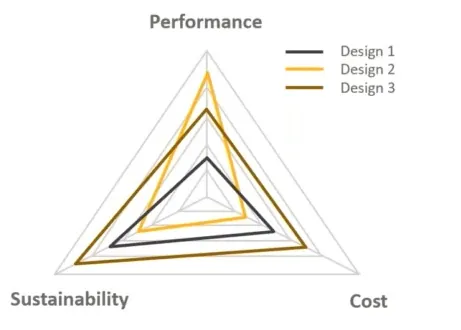Innovating today for a sustainable tomorrow

Born from an urgent response to global crises like climate change, deforestation, and widespread pollution, this concept underscores a commitment to preserving our planet for future generations.
It demands innovative approaches that minimize waste, conserve natural resources, and bolster energy efficiency. As we confront these challenges, the integration of cutting-edge technologies and sustainable practices in various domains—from industrial operations to urban planning—has become crucial.
This holistic approach is not only about ecological conservation but also ensuring economic and social viability, fostering a resilient and inclusive global community.
Across industries, the pressure mounts to align consumer products with environmental goals while maintaining, or even improving, efficiency. Simulation tools have risen to prominence as indispensable assets in this endeavor, revolutionizing engineering and ecological preservation alike. These tools, by simulating real-world conditions without the need for physical prototypes, significantly cut waste and resource use—key aspects of sustainable engineering.
Advanced simulation integrates a myriad of physical phenomena—fluid dynamics, electromagnetism, structural mechanics—and becomes integral from the earliest design stages. This allows for eco-optimized products that adhere to sustainability from inception. The incorporation of digital twin technology further enhances this approach, predicting maintenance needs and extending product longevity, thus embedding sustainability deep within lifecycle management.
The ‘Magic Triangle’ represents a strategic approach in design that skillfully balances performance, environmental impact, and cost. This concept underscores the importance of harmonizing these three crucial dimensions to produce truly effective and holistic solutions.
For example, a high-performance product that is either too costly or detrimental to the environment misses the mark of comprehensive design excellence. Similarly, an affordable and eco-friendly product that

The Magic Triangle Methodology
fails to perform adequately may not meet consumer expectations.
The magic of this triangular approach lies in its ability to identify and exploit the optimal intersection of these factors, resulting in innovative, accessible, and sustainable solutions.
By urging designers and engineers to creatively merge suitable materials, technologies, and processes, the ‘Magic Triangle’ paves the way for
revolutionary products that set new benchmarks in their respective markets. As we navigate the dual challenges of maintaining environmental integrity and economic viability, the role of integrated tools like engineering simulations becomes increasingly significant, ensuring that sustainable innovations are not just conceptual ideals but practical realities.
As industries continue to face the dual challenges of environmental sustainability and economic competitiveness, the role of engineering simulation tools is growing. These tools not only help companies innovate and improve their products but also ensure that these improvements are sustainable over the long term. With tools such as Ansys Discovery, bringing simulation into the design process at a much earlier stage gives even greater efficiency and quickly gives an overview, and when linked with materials database resources within Ansys Granta, designs can be optimized with the ‘Magic Triangle’ methodology at their heart.
Simulation tools stand out as pivotal across many industries, enhancing efficiency and sustainability in remarkable ways. By accurately predicting real-world behaviors, these tools allow for significant advancements in design and operational processes, minimizing environmental impact while maximizing performance.
From optimizing resource use and energy efficiency to extending product lifecycles and spearheading innovations in renewable energy, the benefits of simulation are both profound and pervasive.
Four key areas where simulation technology is not just making improvements, but revolutionizing industry standards:
Resource Efficiency: simulation tools help in optimizing material use, ensuring that products achieve the highest strength with the minimum amount of material. This not only conserves resources but also reduces the energy consumed in manufacturing processes. For instance, automotive companies can create lighter components that make vehicles more fuel-efficient. Using structural simulation coupled with materials data ensures there is no compromise in performance and safety.
Energy Optimization: simulation offers deep insight into energy flows and efficiencies in systems ranging from single components to entire buildings. This allows for designing more efficient systems that reduce energy consumption, crucial for reducing the carbon footprint of any industry.
Lifecycle Analysis: assessing the environmental impact of a product throughout its lifecycle—from extraction of raw materials to disposal – is comprehensive. This view enables manufacturers to identify and mitigate environmental impacts at every stage, fostering a more sustainable product lifecycle.
Innovation in Renewable Energy: simulation tools are instrumental in the renewable energy sector. They are used to design and optimize wind turbine blades, solar panels, and battery systems, enhancing the efficiency and viability of these technologies. By improving the performance of renewable energy systems, simulation helps increase their adoption and reduce reliance on fossil fuels.
Incorporating simulation into core industrial processes not only contributes significantly to environmental preservation but also combats climate change.
As we advance towards a more sustainable future, the strategic use of simulation tools is pivotal in weaving environmental consideration into the fabric of industrial innovation.
These tools ensure that our strides towards cleaner, smarter production are grounded in practical, sustainable practices that will carry us into a new era of environmental responsibility.
Find out more about how EDRMedeso is helping companies achieve their sustainability targets
